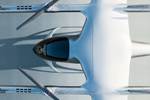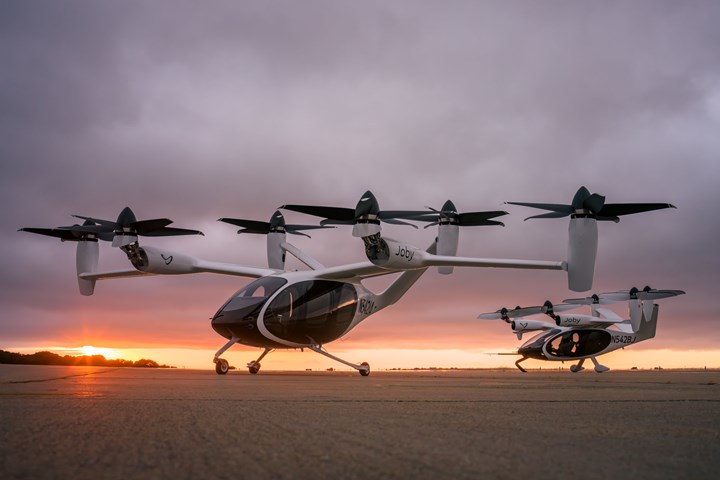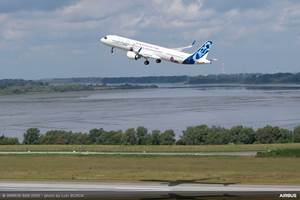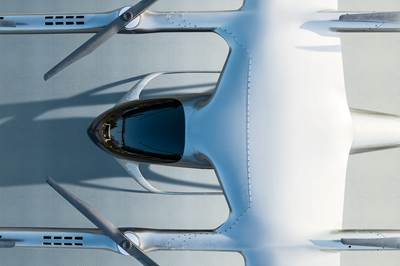Joby marks production launch, receives permit to fly first eVTOL prototype
Joby has received a Special Airworthiness certificate for its first composites-intensive aircraft built at the company’s pilot production line built in close collaboration with Toyota, enabling flight testing to begin.
The first eVTOL aircraft to come off of Joby’s pilot production line in Marina, California, is shown at left. Photo Credit, all images: Joby Aviation
On June 28, Joby Aviation (Santa Cruz, Calif., U.S.) announced that it has received a Special Airworthiness certificate for the first electric vertical takeoff and landing (eVTOL) aircraft built at its pilot production line in Marina, California. Issued by the Federal Aviation Administration (FAA), the certificate enables Joby to begin flight testing of its first production prototype.
The aircraft is expected to become the first eVTOL vehicle to be delivered to a customer when it moves to Edwards Air Force Base in 2024 to be operated by Joby as part of the company’s Agility Prime contract with the U.S. Air Force, worth up to $131 million.
Joby has been flying full-size aircraft since 2017 and its pre-production prototype aircraft have flown more than 30,000 miles since 2019. This latest production prototype builds on that experience and marks another important step toward achieving FAA certification and production at scale.
“We’re proud to have launched production in our home state of California,” JoeBen Bevirt, founder and CEO of Joby, comments. “I’m grateful to the Joby team for their commitment to ensuring Joby remains the clear leader in this new sector and to Toyota for sharing their knowledge and experience with us over many years. Their support has been indispensable in helping us reach this point.”
California Governor Gavin Newsom visited Joby’s facilities prior to the announcement to meet with Joby team members and celebrate the company’s progress.
Moreover, recognizing the key role Toyota (Japan) has played in the design of Joby’s pilot production line, as well as in the production and assembly of the Joby aircraft (read more this in CW’s Joby plant tour), Tetsuo “Ted” Ogawa, president and CEO of Toyota Motor North America Inc., joined more than 1,000 guests and team members at Joby’s Marina facility to celebrate the launch of production. Toyota is Joby’s largest external shareholder, having invested around $400 million in the company, and the two companies recently signed a long-term agreement for the supply of powertrain and actuation components.
California Governor Gavin Newsom (right) and JoeBen Bevirt, Joby Aviation’s founder and CEO (left), standing in front of the aircraft.
Ogawa, who joined Joby’s board of directors on July 1, 2023, says, “We congratulate Joby on reaching this milestone and look forward to working ever more closely as Joby prepares to scale production and start operations.”
Joby’s production prototype aircraft has been manufactured in accordance with a released design and built according to a complete implementation of a quality management system — an important step on the path to achieving the FAA type certification required to begin commercial passenger operations.
Joby plans to begin commercial passenger operations in 2025 and recently partnered with Delta Air Lines (Atlanta, Ga., U.S.) to deliver seamless, emissions-free travel for Delta customers traveling to and from airports.
The aircraft will now undergo initial flight testing before being delivered to Edwards Air Force Base, California, where it will be used to demonstrate a range of potential logistics use cases.
For more updates regarding Joby’s developments, also read, “GKN Aerospace, Joby Aviation sign aerostructures agreement.”
Related Content
Composites end markets: Aerospace (2023)
With COVID in the past and passengers flying again, commercial aircraft production is ramping up. The aerocomposites supply chain is busy developing new M&P for an approaching next-generation aircraft program.
Read MoreJEC World 2022, Part 1: Highlights in sustainable, digital, industrialized composites
JEC World 2022 offered numerous new developments in composites materials, processes and applications, according to CW senior editor, Ginger Gardiner, most targeting improved sustainability for wider applications.
Read MoreInfinite Composites: Type V tanks for space, hydrogen, automotive and more
After a decade of proving its linerless, weight-saving composite tanks with NASA and more than 30 aerospace companies, this CryoSphere pioneer is scaling for growth in commercial space and sustainable transportation on Earth.
Read MoreComposites opportunities in eVTOLs
As eVTOL OEMs seek to advance program certification, production scale-up and lightweighting, AAM’s penetration into the composites market is moving on an upward trajectory.
Read MoreRead Next
AutoFlight, Groupe ADP to conduct experimental piloted eVTOL flights
The recently unveiled Prosperity I aircraft, targeting affordable urban and regional flights, will be tested under real-world conditions during the 2023 Paris Olympic and Paralymic Games at the Pontoise vertiport.
Read MoreCOMAC reports C919 flight testing is complete
Seven C919s have been built and flown to date, with test flights at four locations across China. Composites continue to be key elements for the nacelle system, aircraft tail and more.
Read MoreFrom the CW Archives: The tale of the thermoplastic cryotank
In 2006, guest columnist Bob Hartunian related the story of his efforts two decades prior, while at McDonnell Douglas, to develop a thermoplastic composite crytank for hydrogen storage. He learned a lot of lessons.
Read More




























